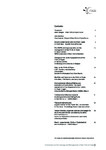Maerl - a spectacular Firth of Clyde habitat.
| dc.contributor.author | Hall-Spencer, Jason | |
| dc.date.accessioned | 2013-02-22T14:49:48Z | |
| dc.date.available | 2013-02-22T14:49:48Z | |
| dc.date.issued | 2001-01-01 | |
| dc.identifier.uri | http://hdl.handle.net/10026.1/1404 | |
| dc.description.abstract |
Pioneering marine biologists were drawn to study the diversity of organisms found in the Firth of Clyde throughout the 19th century. In 1885, naturalists decided to study this diversity in detail and moved a floating laboratory (the ‘Ark’) from the relatively impoverished waters of the Firth of Forth to Millport on the Isle of Cumbrae. The move proved a great success and one of the numerous advances made over the next decade was the discovery of local maerl communities. The proximity of a range of marine habitats located within sheltered waters clinched the decision to establish the first Scottish marine biological station in Millport in 1896. Since these early beginnings we have learnt that the fjordic west coast of Scotland has the lion’s share of European maerl beds and that the Firth of Clyde is no exception. Maerl beds remain poorly known, however, since few people have ever seen these attractive habitats. They have never featured on natural history programmes, are predominantly subtidal and often occur in remote areas. So what exactly are these elusive marine habitats? | |
| dc.language.iso | en | |
| dc.title | Maerl - a spectacular Firth of Clyde habitat. | |
| dc.type | conference | |
| plymouth.issue | The ecology and management of the Firth of Clyde | |
| plymouth.conference-name | Conference on the Ecology and Management of the Firth of Clyde | |
| plymouth.journal | Firth of Clyde Forum | |
| plymouth.organisational-group | /Plymouth | |
| plymouth.organisational-group | /Plymouth/Faculty of Science and Engineering | |
| plymouth.organisational-group | /Plymouth/PRIMaRE Publications | |
| plymouth.organisational-group | /Plymouth/REF 2021 Researchers by UoA | |
| plymouth.organisational-group | /Plymouth/REF 2021 Researchers by UoA/UoA07 Earth Systems and Environmental Sciences | |
| plymouth.organisational-group | /Plymouth/Research Groups | |
| plymouth.organisational-group | /Plymouth/Research Groups/Marine Institute | |
| plymouth.organisational-group | /Plymouth/Users by role | |
| plymouth.organisational-group | /Plymouth/Users by role/Academics | |
| dc.publisher.place | Glasgow | |
| dc.publisher.place | Glasgow | |
| dcterms.dateAccepted | 2001-01-01 | |
| dc.rights.embargodate | 2023-10-3 | |
| dc.rights.embargoperiod | Not known | |
| rioxxterms.licenseref.uri | http://www.rioxx.net/licenses/all-rights-reserved | |
| rioxxterms.type | Conference Paper/Proceeding/Abstract |


